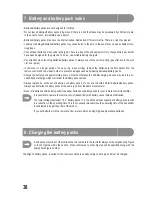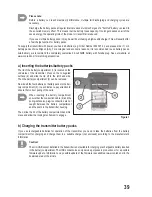
46
b) Installing the receiver
The installation of the receiver differs according to the model. For this reason, observe the recommendations made by
the model manufacturer with regard to installation.
Generally speaking, you should always try to install the receiver in such a way that it is optimally protected from dust,
dirt, damp and vibrations. Double-sided adhesive foam or rubber rings are suitable for securing the foam wrapped
receiver firmly in place.
The last 3 centimetres of the aerial wire are deemed the aerial. The remaining part only serves to extend the aerial,
to place or position it in a model.
The last 3 centimetres of the aerial wire are deemed the aerial. The remaining part only serves to extend the aerial,
to place or position it in a model.
Install the aerial (i.e. the last 3 centimetres) with suitable aids (e.g. the aerial tube from the delivery) so that it points
from the RC box or model as vertically as possible. Generally, the following rule applies: The higher the aerial protru-
des from a model, the safer the reception.
The antenna wire of the receiver has a precisely calculated length. For this reason, the antenna wire may
not be coiled, looped or cut. The range of the transmitter would otherwise be severely limited and this
would represent a considerably safety risk.
c) Installing the servo
The installation of a servo is always dependant on the model being used. Precise information can be obtained from
the construction documents of the model.
In the event of stiff rudders and steering, servos are unable to operate in the required position. They consume un-
necessary power as a result and the model cannot be controlled cleanly.
Always mount the servo lever at a 90° angle to the steering rods. With a servo lever diagonal to the steering rods, the
steering or rudder movement in both steering directions are not of the same magnitude.
Pay attention before installing the servo lever for the drive and steering function to ensure that the trim
function of the relevant channel is set to the middle position. For more information, consult the section
"Checking and setting the digital trimming" in Chapter 10.
The servo lever at the servo for CH3 must be assembled so that it cannot run to block when switching
from one end position to the other.
Summary of Contents for GT3.2
Page 122: ...122 ...
Page 123: ...123 ...
















































